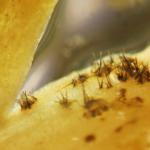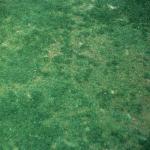Anthracnose Foliar Blight and Basal Rot
Anthracnose, caused by the fungus Colletotrichum cereale, is an important disease on golf courses. The pathogen may cause a foliar blight or a rot of crowns, stolons, and roots. In Poa annua the disease appears throughout the season, while on Agrostis spp. it most often occurs in summer or early autumn. Symptoms of foliar blight are most evident during the summer stress period and include a yellowing to reddish brown discoloration of leaves and a general thinning of the turf. Leaves die from their tips down. The distinctive fruiting bodies (acervuli) of the fungus with their protruding, black, hairlike structures (setae) can be observed with a hand lens. Basal rot occurs when the crown tissues become infected and scattered plants or small patches of plants turn yellow and die. Close examination of the infected stem base reveals a water-soaked black rot of the crown tissue. Spring outbreaks can be very destructive on greens. Basal rot can be extremely difficult to suppress when it becomes a chronic problem. In warm weather, turf infected by anthracnose basal rot turns reddish brown or yellow and the turf thins out in large, irregularly shaped patterns.
Colletotrichum cereale is particularly damaging to annual bluegrass, but has also been reported on creeping bentgrass, Kentucky bluegrass, fine-leaf fescues, perennial ryegrass, and bermudagrass. The pathogen seldom attacks both P. annua and Agrostis spp. in the same green or golf course, indicating a degree of host specificity among isolates. Anthracnose survives in plant debris as a saprophyte or as a pathogen in infected plant material and is favored by conditions that stress the turfgrass such as low fertility, heat stress, low mowing height, poor soil drainage, compaction, excessive thatch, and heavy traffic. Disease development is favored by high humidity, shade, and any condition that allows excess water to remain in the leaf canopy. Conidia can be spread by wind, water, or human activity.
Ultra-low mowing (0.125 in), increased mowing frequency, lightweight rolling, and abrasive grooming practices such as sand topdressing were previously thought to increase anthracnose severity, primarily by causing small wounds. Recent research at Rutgers University challenged these long held assumptions. The data indicate that anthracnose severity is not correlated with wounding; in fact, frequent, light sand topdressing has a cumulative beneficial effect. Such topdressing appears to protect the crown from the stress caused by low mowing heights. While disease severity is not related to wounding, it is directly related to turf stress.
Cultural Management
Alleviate conditions that cause turf stress. Preventive applications of fungicides are recommended where the disease is a chronic problem.
- Fertilize with complete fertilizers, avoiding deficiencies of potassium and phosphorous.
- Adequate nitrogen fertilization (~3.0 lb/1,000 ft2/year) is critical to reducing anthracnose severity on annual bluegrass putting greens. Weekly applications of 0.1 lb/1,000 ft2 during summer months significantly reduce disease. Do not apply nitrogen at high rates during periods of high temperature stress or drought
- Water deeply and infrequently. Basal rot anthracnose is enhanced by both excessively wet or excessively dry conditions. Irrigation at 60-80% of ET (evapotranspiration) is preferred for anthracnose management.
- Increase mowing height and reduce mowing frequency. Mowing below 0.125 inch should be avoided. Cutting heights of 0.141 inch and slight increases in mowing height can significantly reduce disease severity. Green speed can be maintained by rolling.
- Reduce soil compaction by core aeration in spring and fall.
- Manage thatch.
- Modify traffic patterns and move cups frequently.
- Minimize leaf wetness by improving air circulation (pruning of trees and shrubs), watering early in the day, and/or dew removal.
- Wash mowers thoroughly after mowing areas where disease is active.
- Consider renovating greens with newer bentgrass cultivars, which are generally less susceptible to anthracnose than older ones.
See also: Anthracnose: Why is it so Difficult to Control?
Management with Fungicides
Preventive fungicide applications are more effective than curative applications. For basal rot, a systemic fungicide should be applied and watered in to reach the crown area. Follow with a separate application of a protectant. Use of Group 3 fungicides (DMIs) should be avoided during the summer stress period to avoid growth regulator effects. Fungicide resistant strains of C. cereale are widespread: rotation of active ingredients is critical for the prevention of resistance.
For a listing of fungicides currently labeled to manage this disease, refer to the Disease Management chapter of UMass Extension's Professional Guide for IPM in Turf for Massachusetts.



